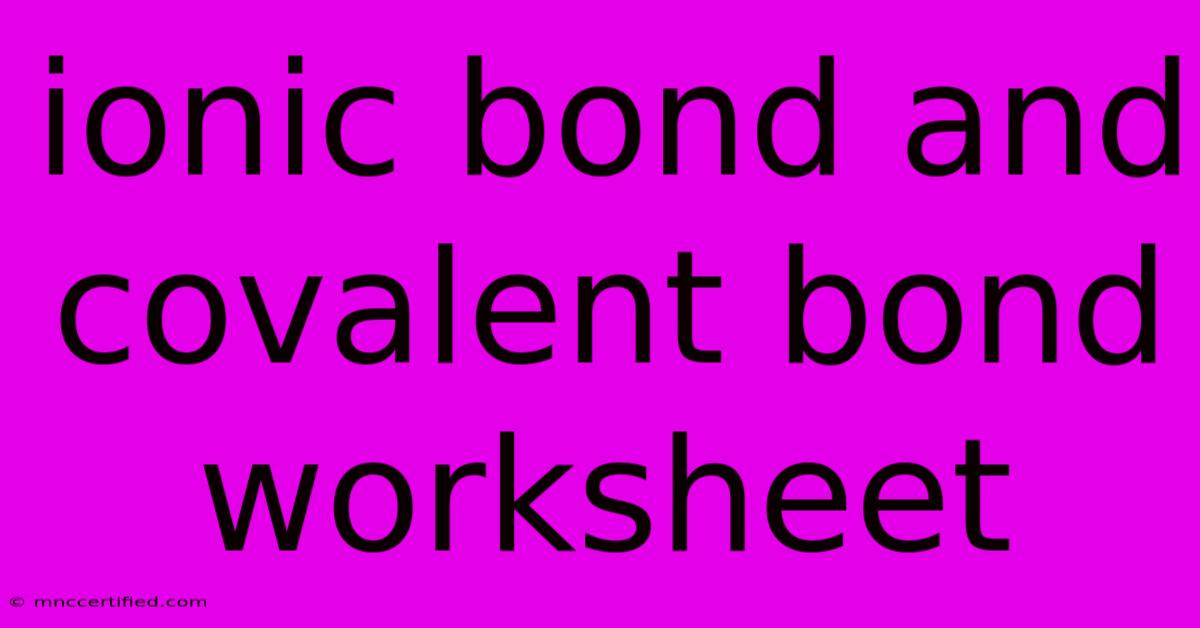Ionic Bond And Covalent Bond Worksheet

Table of Contents
Unlocking the Secrets of Bonding: Ionic vs. Covalent – A Worksheet Companion
Understanding the fundamental principles of chemical bonding is essential for mastering chemistry. This worksheet focuses on two crucial types of bonds: ionic bonds and covalent bonds. By working through the exercises, you'll gain a deep understanding of how these bonds form, their characteristics, and how to identify them in different molecules.
Ionic Bonds: The Dance of Opposites
Ionic bonds form between metals and nonmetals. The metal atom loses electrons, becoming a positively charged ion (cation), while the nonmetal atom gains electrons, becoming a negatively charged ion (anion). These oppositely charged ions are then strongly attracted to each other, creating the ionic bond.
Key Characteristics of Ionic Bonds:
- High melting and boiling points: Due to the strong electrostatic forces between ions.
- Good conductors of electricity when dissolved in water: The ions are free to move and carry charge.
- Form crystalline solids: The repeating arrangement of ions in a lattice structure.
- Usually formed between elements with large differences in electronegativity: One element has a strong pull on electrons, while the other has a weak pull.
Covalent Bonds: Sharing is Caring
Covalent bonds form when two or more nonmetal atoms share electrons to achieve a stable electron configuration. These shared electrons create a strong bond between the atoms.
Key Characteristics of Covalent Bonds:
- Lower melting and boiling points: Compared to ionic bonds, as the forces holding the atoms together are weaker.
- Poor conductors of electricity: As electrons are not free to move.
- Can be solid, liquid, or gas at room temperature: Depending on the strength of the bonds.
- Usually formed between elements with similar electronegativity: Both elements have a similar pull on electrons, leading to sharing.
Let's Get to Work: Worksheet Activities
This worksheet will help you practice recognizing and understanding these different bond types:
Activity 1: Identifying the Bond Type
Instructions: For each pair of elements, determine whether the bond formed would be ionic or covalent.
- Sodium (Na) and Chlorine (Cl)
- Carbon (C) and Oxygen (O)
- Calcium (Ca) and Fluorine (F)
- Hydrogen (H) and Nitrogen (N)
- Potassium (K) and Bromine (Br)
Activity 2: Drawing Lewis Structures
Instructions: Draw Lewis structures for the following molecules, showing the sharing of electrons in covalent bonds.
- Water (H₂O)
- Methane (CH₄)
- Carbon Dioxide (CO₂)
Activity 3: Applying Your Knowledge
Instructions: Answer the following questions:
- What are the key differences between ionic and covalent bonds?
- Explain why ionic compounds are typically solid at room temperature.
- What are the advantages of using Lewis structures to represent molecules?
- How do the properties of ionic and covalent compounds relate to their uses in everyday life?
Wrapping Up: Mastering Chemical Bonding
By completing this worksheet, you'll have a solid foundation in understanding the fundamental differences between ionic and covalent bonds. Remember, these are not just theoretical concepts; they have real-world implications in areas such as medicine, materials science, and environmental studies. So, keep practicing, keep learning, and unlock the fascinating world of chemical bonding!

Thank you for visiting our website wich cover about Ionic Bond And Covalent Bond Worksheet. We hope the information provided has been useful to you. Feel free to contact us if you have any questions or need further assistance. See you next time and dont miss to bookmark.
Featured Posts
-
Thousands Call For Christmas Bonus Rise Dwp Responds
Nov 09, 2024
-
Pompeii Casts Identities Not As Clear Cut
Nov 09, 2024
-
Pet Shop Boys Take On All The Young Dudes
Nov 09, 2024
-
Do I Need Insurance When I Rent A Boat
Nov 09, 2024
-
Cheese Recall Check Your Groceries
Nov 09, 2024